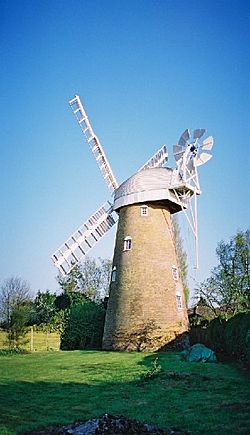Stock Windmill facts for kids
Quick facts for kids Stock Mill |
|
|---|---|

The restored mill, June 2004
|
|
| Origin | |
| Mill name | Stock Mill |
| Grid reference | TQ 698 987 |
| Coordinates | 51°39′43″N 0°27′22″E / 51.662°N 0.456°E |
| Operator(s) | Essex County Council |
| Year built | c1816 |
| Information | |
| Purpose | Corn mill |
| Type | Tower |
| Storeys | Five storeys |
| No. of sails | Four sails |
| Type of sails | Patent sails |
| Windshaft | Cast iron |
| Winding | Fantail |
| Fantail blades | Six blades |
| Auxiliary power | Internal combustion engine |
| No. of pairs of millstones | Three pairs |
| Size of millstones | 5 feet (1.52 m), 4 feet 7 inches (1.40 m) and 4 feet (1.22 m) |
Stock Windmill is a very old and important windmill. It is located in Stock, Essex, England. This special building is known as a grade II* listed tower mill. It has been carefully fixed up so people can visit it today.
Contents
History of Stock Windmill
Stock Windmill was built around 1816. It was built next to another type of windmill called a post mill. Later, in 1845, a second post mill was moved nearby.
By 1862, Stock Windmill had four special sails that could be adjusted. The two older post mills were taken down around 1890. Around that time, the heavy millstones inside Stock Windmill were moved to a lower floor. The way the millstones were powered also changed.
In 1902, a steam engine was added to help the mill work. The windmill continued to grind grain using wind power until 1930. After that, it used an internal combustion engine until about 1936.
Essex County Council bought the mill in 1945 to protect it. By 1977, parts of the mill were missing, like its fantail and some support beams. It also had only one pair of sails left.
Major repairs began in 1991. A grant from English Heritage helped pay for this work. The restoration was finished in 1993. At that time, a group called the Friends of Stock Mill was formed to help look after it.
How Stock Windmill Works
Stock Windmill is a five-storey tower mill. This means it has five levels inside. It has four single Patent sails. These sails can adjust themselves automatically to catch the wind.
The top of the mill has a boat-shaped cap. This cap turns to face the wind. It is turned by a six-bladed fantail. A fantail is a small windmill at the back that automatically keeps the main sails facing the wind.
The tower is about 20 feet 6 inches wide inside at the bottom. It narrows to about 12 feet 6 inches wide at the top. The walls are very thick, about 22 inches at the bottom and 18 inches higher up. The whole tower is about 40 feet tall. With the cap on top, the mill reaches about 52 feet high.
When it was first built, the mill had a platform at the first-floor level. It had four simpler sails and had to be turned by hand to face the wind. It originally powered two pairs of millstones from above.
The main shaft that holds the sails is made of cast-iron. It might not have been made for this mill originally. This shaft connects to a large brake wheel, which is about 9 feet 4 inches across. This wheel has 81 teeth. It drives another cast-iron wheel called a wallower, which has 25 teeth.
A strong cast-iron shaft, about 5 inches wide, goes straight down through the mill. It is made of three parts joined together. This shaft connects to a large gear wheel called the great spur wheel. This wheel is about 5 feet wide and has 76 teeth. It used to power three pairs of millstones from below. These millstones were different sizes: 5 feet, 4 feet 7 inches, and 4 feet wide.
Millers of Stock Windmill
Many people worked as millers at Stock Windmill over the years:
- William Moss Sr (from 1816)
- William (Jr) & John Moss (until 1838)
- William Moss Jr (until 1853)
- John Pertwee (1863–1866)
- Joseph Clover (1870–1890)
- Mary Clover (1894–1898)
- William Mayes (1902–1917)
- Frank Semmens (1926–1929)
Visiting Stock Windmill
Stock Windmill is open to the public. You can visit it on the second Sunday of each month. It is open from April through September.

